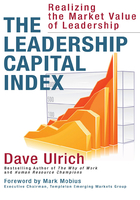
Past Performance and Experience
Nearly every investor my colleagues and I interviewed said that the best predictor of a future leadership success is past performance and experience (a point of view not currently shared by most of the academic thought leaders whose criteria are summarized in Table 2.4; this interesting divergence may reflect a gap between practical application and theory). For the most part, investors insist on a favorable track record; they hesitate to deal with a leader without one, and it is true that past performance remains the best predictor of future performance. Leaders create patterns of how they work and those patterns show up in present and future settings. One investor tracks leaders by the organization results they produce; he looks at free cash flow versus industry average over a decade. While such a cash surplus is a useful macro indicator of performance, many factors may go into it. More specifically, investors can confirm how well leaders meet commitments they make by looking at five to ten years of performance reviews to see what goals were set and the pattern of how well these commitments were achieved. In addition to looking at historical managerial commitments, investors can observe performance predictability by tracking recent financial and personal goals.
Although past performance is invaluable as a leadership predictor, it is not foolproof. Leaders may bring the skills from their last assignment to their current assignment but find that they do not match the requirements of that assignment. In addition, effective leaders who want to improve do not want to do what they have always done; they want to learn and grow.
In our work, my colleagues and I have found that leaders who worked in a company with a strong identity and distinct culture often tried to transplant their experience when they moved to another company. Many General Electric alumni tried to transfer the GE culture to their new company—and failed. In their second post-GE career move, these leaders were better able to recognize that their personal style had to match the requirements of their new organization, and they had more success.
In their second post-GE career move, these leaders were better able to recognize that their personal style had to match the requirements of their new organization, and they had more success.
A major investor in Brazil said that he looked for leaders who managed to deliver consistent and sustainable results in different settings. Investors can look at leaders' careers and seek a couple of indicators of past experience and success. First, in early career experiences, did the leaders demonstrate successful habits? For example, in school, did they take challenging classes or easy ones? In early career assignments, did they innovate or follow? When they describe previous career experiences, do they talk about positions, activities, or results?
Second, the investor looks for multifaceted career mosaics demonstrating that leaders learned to succeed in different settings. Career evolution can be evaluated by the stretch assignments, where leaders gain diverse experiences by moving quickly but also have time to fully appreciate and learn from each assignment. In addition, investors should assess whether the experiences enable the leaders to lead the company at hand. For example, one investor told us that he was skeptical of leaders who had worked for twenty years in a traditional hierarchical organization but then had a good idea and wanted to lead a start-up with little infrastructure and a small staff.
Possible indicators:
 What is the free cash flow of the leader’s business compared to that of competitors over time?
What is the free cash flow of the leader’s business compared to that of competitors over time?
 How successful has the leader been at meeting performance commitments in previous assignments?
How successful has the leader been at meeting performance commitments in previous assignments?
 What has the leader’s career path been? Similar or different assignments? Safe assignments or risky ones?
What has the leader’s career path been? Similar or different assignments? Safe assignments or risky ones?